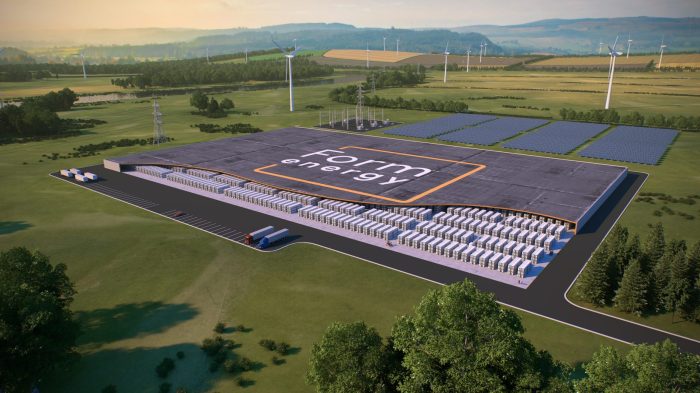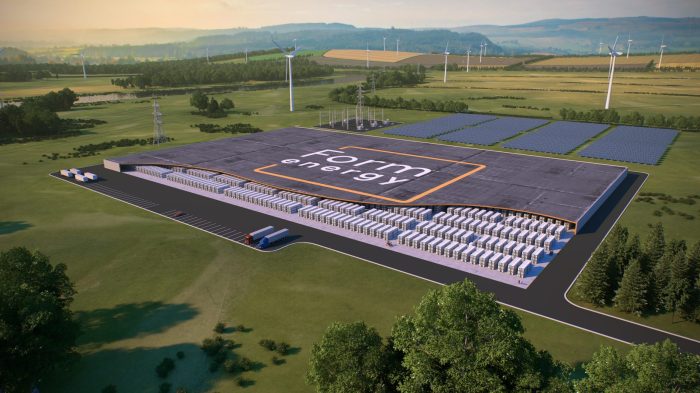Energy Dome CO2 battery funding is making waves in the energy storage sector, promising a novel approach to storing renewable energy. This technology leverages the power of carbon dioxide to create a battery that can store large amounts of energy for extended periods, potentially revolutionizing the way we power our homes and industries.
Imagine a world where solar and wind power are not only sustainable but also reliable, with the ability to store excess energy for use during peak demand or when the sun isn’t shining. This is the vision Energy Dome is pursuing, and their innovative CO2 battery technology is attracting significant investment.
Energy Dome Technology: Energy Dome Co2 Battery Funding
Energy Dome is a company that has developed a novel and promising technology for storing energy using CO2. This technology, known as the CO2 battery, leverages the properties of carbon dioxide to create a cost-effective and efficient energy storage system.
Working Principle of the CO2 Battery
The CO2 battery operates on a simple yet ingenious principle based on the phase change of COThe system uses a closed-loop cycle that involves compressing CO2 into a liquid state, storing it under pressure, and then releasing it to drive a turbine, generating electricity.
The process can be summarized as follows:
- Compression and Liquefaction:During periods of excess electricity generation, such as during peak solar or wind production, the system compresses CO2 gas into a liquid state. This process requires energy, but it is efficiently achieved using excess electricity.
- Storage:The liquefied CO2 is then stored under pressure in a large, insulated tank. This storage phase allows for the accumulation of energy for later use.
- Expansion and Power Generation:When energy is needed, the stored liquid CO2 is released from the tank and expanded through a turbine. This expansion process converts the stored energy into mechanical energy, which drives the turbine and generates electricity.
Key Components of the CO2 Battery
The CO2 battery system consists of several key components that work together to achieve efficient energy storage and release:
- Compressor:The compressor is responsible for compressing the CO2 gas into a liquid state. This process requires energy, which is typically provided by excess electricity from renewable sources.
- Storage Tank:The storage tank is a large, insulated container that holds the liquefied CO2 under pressure. The tank’s insulation helps minimize energy loss during storage.
- Turbine:The turbine is the heart of the energy generation process. When the liquid CO2 is released from the storage tank, it expands through the turbine, converting its stored energy into mechanical energy.
- Generator:The generator converts the mechanical energy produced by the turbine into electricity. This electricity can then be distributed to the grid or used directly by consumers.
Advantages and Disadvantages of CO2 Battery Technology
Compared to traditional energy storage solutions like pumped hydro, lithium-ion batteries, and compressed air energy storage, the CO2 battery offers several advantages:
- Cost-Effectiveness:The CO2 battery technology is considered to be more cost-effective than other energy storage solutions, especially for large-scale deployments. This is because it utilizes readily available and relatively inexpensive materials like CO2 and steel.
- Scalability:The CO2 battery system can be scaled to meet a wide range of energy storage needs. This scalability makes it suitable for both small-scale and large-scale applications, including residential, commercial, and utility-scale energy storage.
- Long Duration:The CO2 battery technology can store energy for extended periods, making it suitable for balancing the intermittent nature of renewable energy sources like solar and wind power. This long duration storage capability is a significant advantage over other storage technologies.
- Environmental Benefits:The CO2 battery technology has the potential to contribute to a cleaner energy future. It utilizes CO2, a greenhouse gas, as a storage medium, potentially reducing CO2 emissions from other industries.
However, the CO2 battery technology also has some disadvantages:
- Efficiency:While the CO2 battery is a promising technology, its efficiency is still under development. The energy conversion process involves some energy losses, which need to be minimized for optimal performance.
- Safety:The storage of high-pressure CO2 requires careful safety considerations. The system needs to be designed and operated to ensure safe storage and handling of the CO2. This aspect requires rigorous engineering and safety protocols.
- Maturity:The CO2 battery technology is still in its early stages of development. While significant progress has been made, further research and development are needed to optimize its performance and address potential challenges.
Funding and Investment
Energy Dome has attracted significant funding to scale its innovative CO2 battery technology. This investment reflects the growing demand for reliable and cost-effective energy storage solutions, particularly in the context of the global transition to renewable energy sources.
Funding Rounds and Investors
The company has secured multiple funding rounds, demonstrating investor confidence in its potential.
Discover how french antitrust raid nvidia offices has transformed methods in this topic.
- Seed Round:In 2019, Energy Dome raised €2 million from investors including the Italian venture capital firm 360 Capital Partners and the European Innovation Council (EIC) Accelerator.
- Series A Round:In 2021, the company secured €20 million in Series A funding led by the Italian venture capital firm CDP Venture Capital, with participation from existing investors and new investors such as Eni Next, the innovation arm of the Italian energy giant Eni.
- Series B Round:In 2023, Energy Dome raised €50 million in Series B funding, led by the European Investment Bank (EIB), with participation from existing investors and new investors such as the European Innovation Council (EIC) Fund and the Italian energy company A2A.
Factors Driving Investment
Several factors have contributed to the significant investment in Energy Dome’s technology:
- Market Demand:The global energy storage market is rapidly growing, driven by the increasing deployment of renewable energy sources, such as solar and wind power, which are intermittent in nature. Energy storage solutions are crucial for ensuring grid stability and reliability by providing a buffer for fluctuations in supply and demand.
- Technological Advantage:Energy Dome’s CO2 battery technology offers several advantages over traditional energy storage solutions, such as lithium-ion batteries. It is significantly cheaper, has a longer lifespan, and is more sustainable, using readily available and environmentally friendly materials.
- Sustainability:Investors are increasingly prioritizing sustainable investments, and Energy Dome’s technology aligns with this trend. Its CO2 battery technology offers a clean and efficient way to store energy, contributing to the reduction of greenhouse gas emissions.
- Strong Team:Energy Dome has assembled a team of experienced professionals with expertise in energy storage, engineering, and business development. This strong team has instilled confidence in investors about the company’s ability to execute its ambitious plans.
Comparison with Other Energy Storage Startups
Energy Dome’s funding strategy is comparable to other energy storage startups that have successfully attracted significant investment. For instance,
- Form Energy:This startup, developing long-duration iron-air batteries, has secured over $1 billion in funding from investors such as Bill Gates’ Breakthrough Energy Ventures and the venture capital firm, Breakthrough Energy Ventures.
- Eos Energy Storage:This company, focusing on zinc-hybrid batteries, has raised over $500 million in funding, including investments from the private equity firm, BlackRock, and the venture capital firm, Prelude Ventures.
These examples illustrate that the energy storage sector is attracting significant capital, particularly for startups developing innovative and scalable technologies. Energy Dome’s success in securing funding highlights the strong investor interest in its CO2 battery technology, which has the potential to play a crucial role in the global transition to a clean energy future.
Applications and Market Potential
Energy Dome’s CO2 battery technology offers a compelling solution for addressing the intermittency challenges associated with renewable energy sources. This innovative technology has the potential to revolutionize various sectors, from renewable energy integration to industrial processes.
Potential Applications
The applications of Energy Dome’s CO2 battery technology are diverse and extend across multiple sectors.
- Renewable Energy Integration:CO2 batteries can play a crucial role in stabilizing the grid by storing excess renewable energy generated during periods of high output and releasing it when demand exceeds supply. This ability to store and discharge energy on demand enables the integration of more renewable energy sources into the grid, contributing to a cleaner and more sustainable energy future.
- Power Grid Reliability:Energy Dome’s technology can enhance the reliability of power grids by providing a rapid and flexible energy storage solution. This is particularly important for ensuring grid stability during peak demand periods or unexpected disruptions in power supply.
- Industrial Processes:CO2 batteries can provide a cost-effective and environmentally friendly solution for storing and releasing energy in industrial processes. This includes applications in manufacturing, chemical production, and other energy-intensive industries.
Market Size and Growth Potential
The market for energy storage is experiencing rapid growth, driven by the increasing adoption of renewable energy sources and the need for grid stabilization. According to a report by MarketsandMarkets, the global energy storage market is expected to reach USD 258.6 billion by 2028, growing at a CAGR of 27.4% during the forecast period.
- Growing Demand for Renewable Energy:The global shift towards renewable energy sources is creating a significant demand for energy storage solutions to address the intermittency challenges associated with solar and wind power. This trend is expected to drive the growth of the CO2 battery market.
- Grid Modernization:The modernization of power grids, with a focus on incorporating smart grid technologies and enhancing grid resilience, is another key factor driving the demand for energy storage solutions. CO2 batteries can play a crucial role in this process.
- Government Incentives:Many governments around the world are implementing policies and providing incentives to promote the adoption of energy storage technologies. These initiatives are expected to further accelerate the growth of the CO2 battery market.
Challenges and Opportunities, Energy dome co2 battery funding
While the market potential for CO2 batteries is significant, Energy Dome faces several challenges in expanding its market reach.
- Competition:The energy storage market is highly competitive, with various established technologies, such as lithium-ion batteries and pumped hydro storage. Energy Dome needs to differentiate its technology and demonstrate its competitive advantages to gain market share.
- Cost:The initial capital cost of CO2 batteries may be higher than some other energy storage technologies. However, Energy Dome is working to reduce costs through technological advancements and economies of scale.
- Deployment:Deploying CO2 batteries requires specialized infrastructure and expertise. Energy Dome needs to collaborate with partners to facilitate the deployment of its technology on a large scale.
- First-Mover Advantage:As a pioneer in CO2 battery technology, Energy Dome has the opportunity to establish itself as a market leader. By demonstrating the viability and scalability of its technology, Energy Dome can capture a significant share of the growing energy storage market.
- Partnerships:Collaborating with key stakeholders, such as utilities, renewable energy developers, and industrial companies, is crucial for Energy Dome to expand its market reach. These partnerships can provide access to resources, expertise, and market opportunities.
- Innovation:Continuous innovation and technological advancements are essential for Energy Dome to remain competitive in the evolving energy storage landscape. The company needs to focus on improving the efficiency, cost-effectiveness, and scalability of its technology.
Environmental Impact and Sustainability

Energy Dome’s CO2 battery technology presents a promising solution for addressing climate change and promoting sustainable energy practices. Its innovative approach to energy storage, utilizing readily available materials and minimizing environmental impact, positions it as a viable alternative to conventional energy storage methods.
Carbon Footprint and Greenhouse Gas Emissions Reduction
Energy Dome’s CO2 battery technology has the potential to significantly reduce greenhouse gas emissions. By storing energy as compressed CO2, the technology effectively captures and sequesters carbon dioxide, preventing its release into the atmosphere. The process involves capturing CO2 from industrial sources or directly from the air and storing it under pressure in a specially designed dome.
When energy is needed, the compressed CO2 is released, driving a turbine to generate electricity. This cycle contributes to reducing greenhouse gas emissions in several ways:
- Carbon Capture and Sequestration:Energy Dome’s technology directly captures and stores CO2, preventing its release into the atmosphere. This contributes to reducing the overall carbon footprint of energy production.
- Reduced Reliance on Fossil Fuels:By providing a reliable and scalable energy storage solution, Energy Dome’s technology can help reduce the reliance on fossil fuels for electricity generation. This, in turn, reduces the emissions associated with burning fossil fuels.
- Integration with Renewable Energy Sources:Energy Dome’s CO2 battery can be integrated with renewable energy sources like solar and wind power, providing a reliable means to store excess energy and ensure a consistent supply of electricity, even during periods of low wind or sunshine.
Resource Requirements and Waste Management
Energy Dome’s technology relies on readily available and sustainable resources. The primary components of the CO2 battery are air, water, and readily available materials like steel and concrete. The technology requires minimal land footprint and can be easily integrated into existing infrastructure.
Additionally, Energy Dome’s technology is designed for long-term sustainability, minimizing waste generation. The CO2 captured and stored in the battery can be reused multiple times, extending the lifespan of the technology and reducing the need for continuous resource extraction.
Comparison with Other Energy Storage Solutions
Energy Dome’s CO2 battery technology offers several advantages over conventional energy storage solutions, particularly in terms of environmental impact and sustainability:
- Lower Environmental Impact:Compared to lithium-ion batteries, which require significant resources for extraction and manufacturing, Energy Dome’s technology relies on readily available and sustainable materials. Additionally, lithium-ion batteries pose environmental concerns related to their disposal and potential for fire hazards.
- Reduced Carbon Footprint:Energy Dome’s technology directly captures and stores CO2, contributing to a lower carbon footprint compared to pumped hydro storage, which often requires significant land use and can impact local ecosystems.
- Scalability and Flexibility:Energy Dome’s CO2 battery technology is scalable and can be deployed in various sizes, making it suitable for both grid-scale and smaller applications. This flexibility allows for customized solutions to meet diverse energy storage needs.
Future Developments and Trends

Energy Dome’s CO2 battery technology is a groundbreaking innovation with the potential to significantly impact the energy storage landscape. The company is actively pursuing research and development efforts to enhance the technology’s performance, expand its applications, and address emerging trends in the energy storage sector.
This continuous evolution will further solidify Energy Dome’s position as a leading player in the clean energy transition.
Research and Development
Energy Dome’s research and development efforts are focused on improving the efficiency, scalability, and cost-effectiveness of its CO2 battery technology. The company is actively pursuing several key areas of research, including:
- Improving CO2 Capture and Storage Efficiency: Energy Dome is exploring ways to enhance the efficiency of CO2 capture and storage processes, aiming to reduce energy consumption and minimize environmental impact. This includes research into new materials and technologies for CO2 capture and storage, as well as optimizing the design of the CO2 battery system.
- Developing Larger-Scale CO2 Batteries: To meet the growing demand for energy storage, Energy Dome is focusing on scaling up the size of its CO2 batteries. This involves developing larger-capacity CO2 storage tanks and optimizing the design of the system to handle increased volumes of CO2.
- Reducing the Cost of CO2 Batteries: The cost of CO2 batteries is a critical factor in their widespread adoption. Energy Dome is actively working on reducing the cost of its technology through various strategies, such as optimizing materials and manufacturing processes, exploring alternative CO2 sources, and developing innovative financing models.
Future Applications and Innovations
Energy Dome’s CO2 battery technology has the potential to be applied in a wide range of applications beyond traditional energy storage. The company is exploring several innovative applications, including:
- Grid-Scale Energy Storage: Energy Dome’s CO2 batteries are well-suited for grid-scale energy storage, providing a reliable and cost-effective solution for balancing supply and demand and integrating renewable energy sources like solar and wind power. This application is particularly relevant in regions with high penetration of intermittent renewables, where energy storage is crucial for ensuring grid stability.
- Industrial Process Heat: Energy Dome’s CO2 battery technology can be used to store thermal energy for industrial processes. This can significantly reduce energy consumption and emissions in industries such as steel production, cement manufacturing, and chemical processing.
- Carbon Capture and Utilization: The CO2 battery technology can be integrated with carbon capture and utilization (CCU) systems, enabling the capture and storage of CO2 from industrial sources and its subsequent use as a valuable resource. This approach can contribute to a circular economy and reduce greenhouse gas emissions.
Impact of Emerging Trends in the Energy Storage Sector
The energy storage sector is rapidly evolving, driven by factors such as the increasing penetration of renewable energy, the need for grid modernization, and the growing demand for electric vehicles. These trends present both opportunities and challenges for Energy Dome’s CO2 battery technology.
- Growing Demand for Long-Duration Storage: The increasing penetration of renewable energy sources, such as solar and wind power, is driving the demand for long-duration energy storage solutions. Energy Dome’s CO2 battery technology, with its ability to store energy for extended periods, is well-positioned to meet this demand.
- Focus on Cost Reduction: The cost of energy storage is a major barrier to its widespread adoption. Energy Dome is actively working on reducing the cost of its CO2 battery technology through various strategies, such as optimizing materials and manufacturing processes, exploring alternative CO2 sources, and developing innovative financing models.
- Integration with Smart Grids: The development of smart grids is creating new opportunities for energy storage. Energy Dome’s CO2 battery technology can be integrated with smart grid systems to optimize energy efficiency, enhance grid stability, and enable the integration of distributed renewable energy sources.





